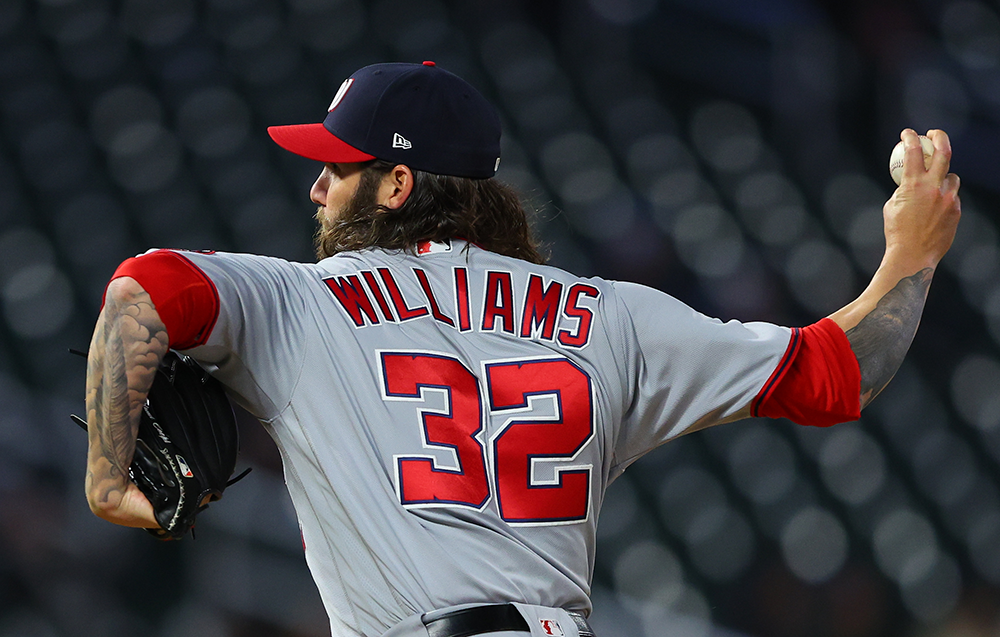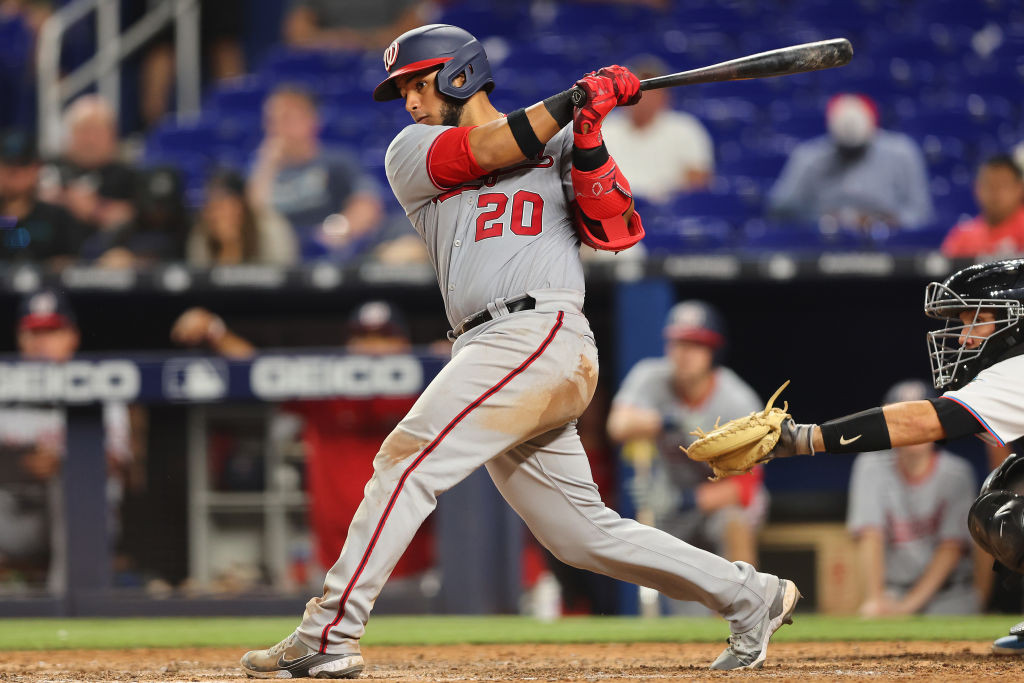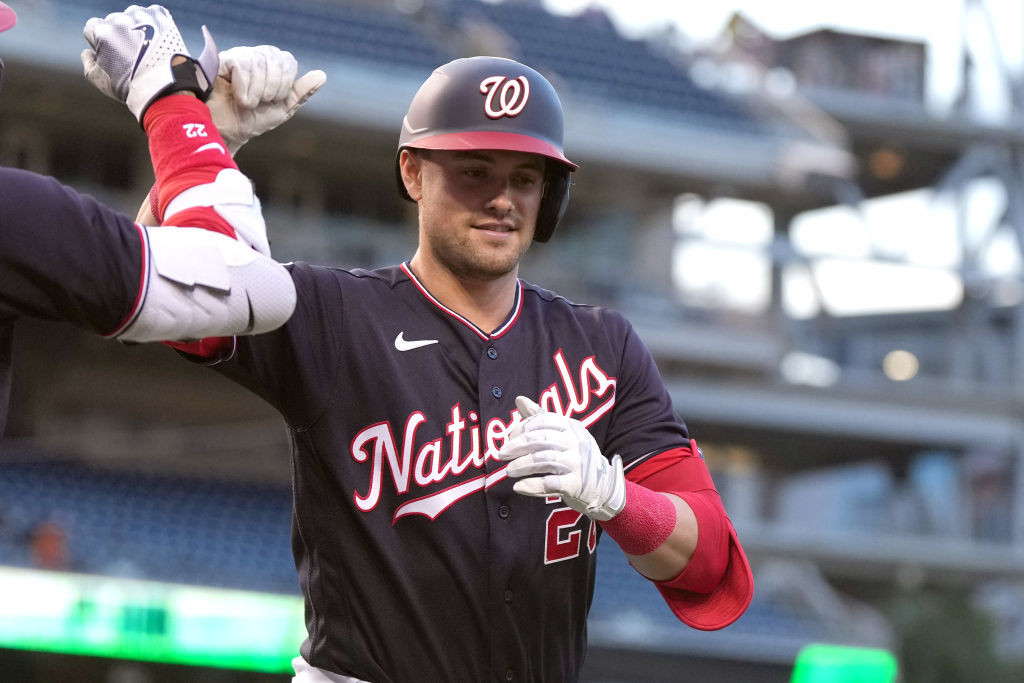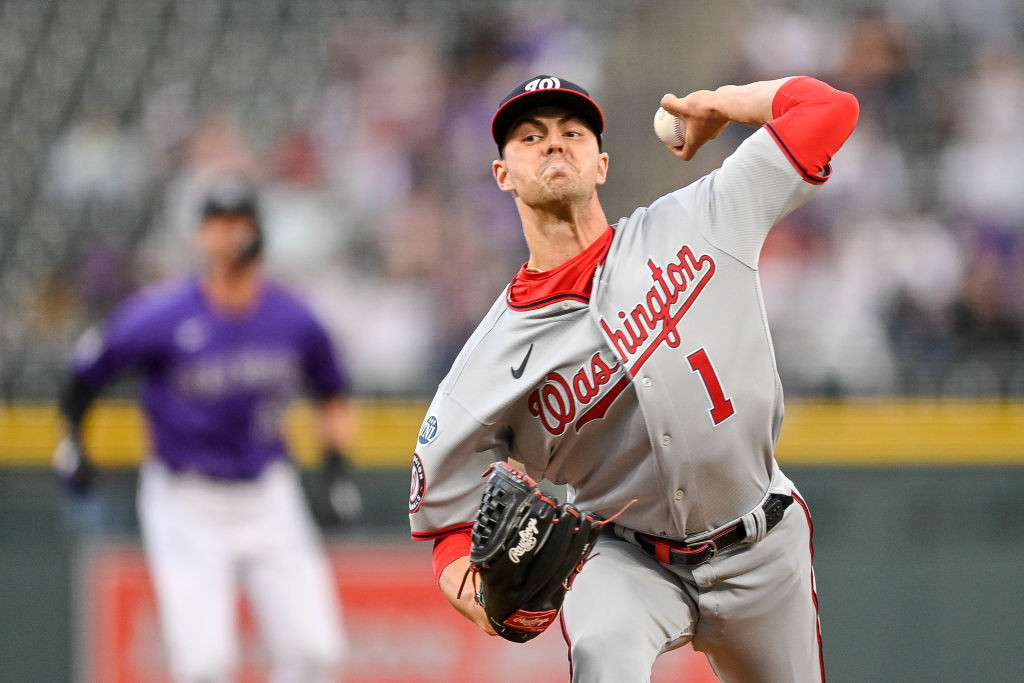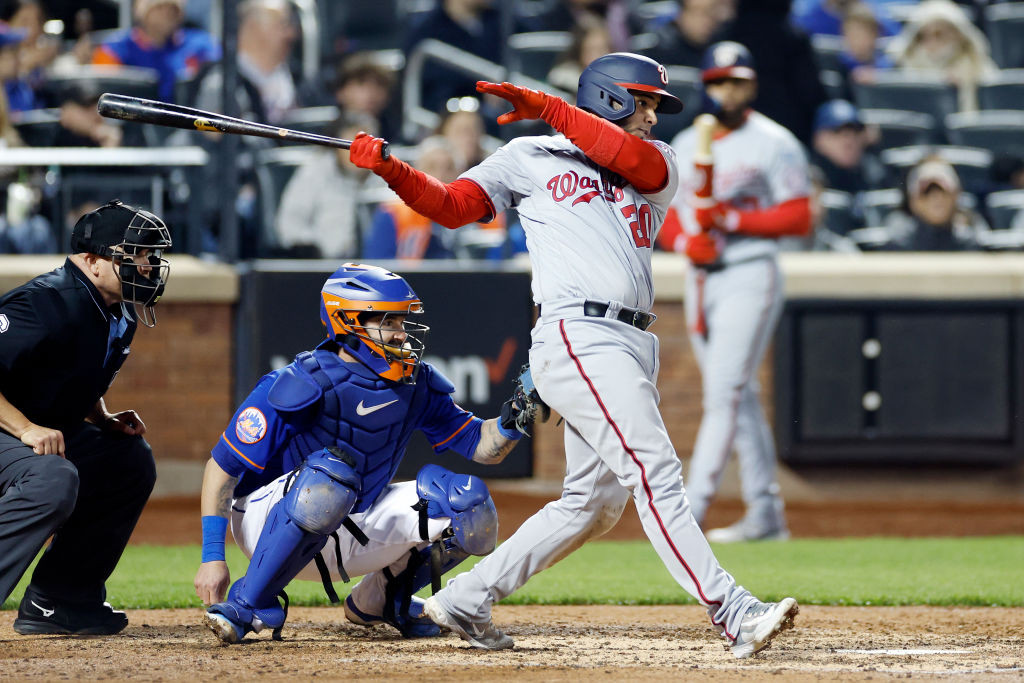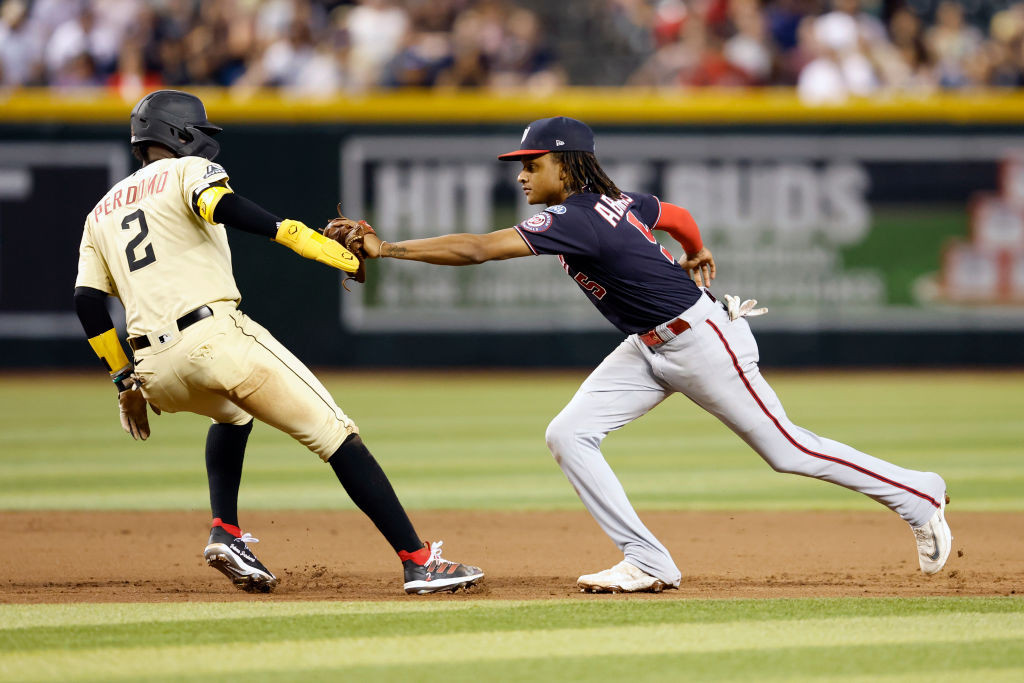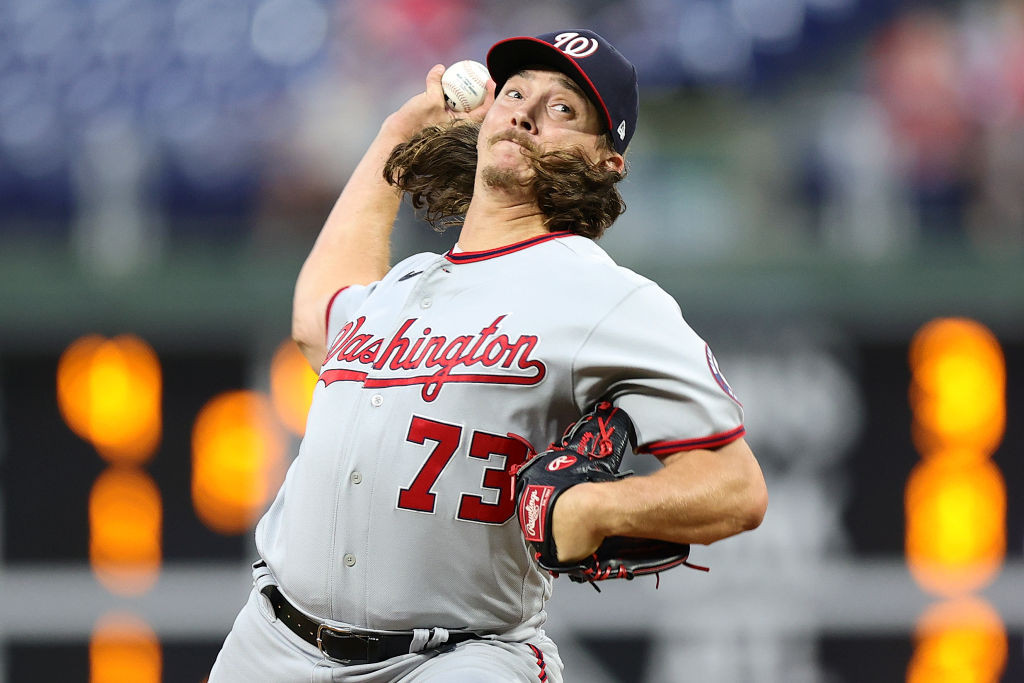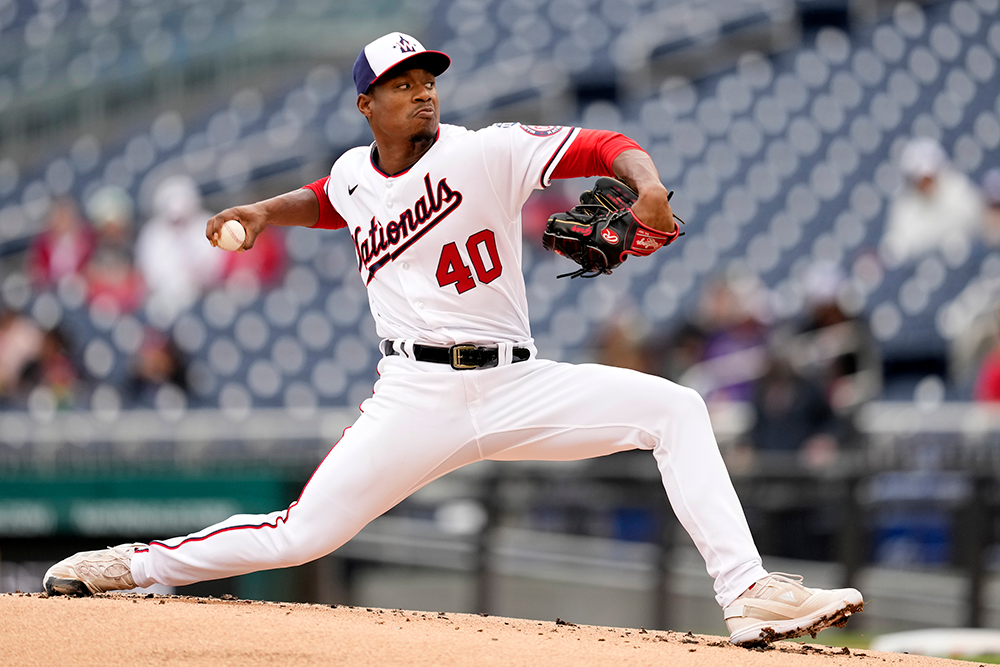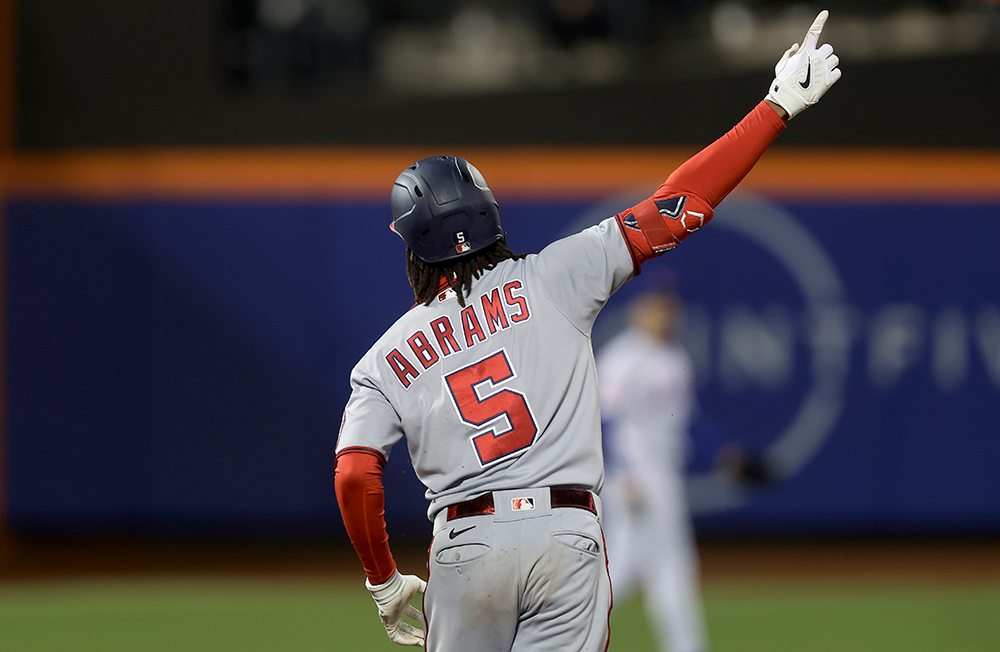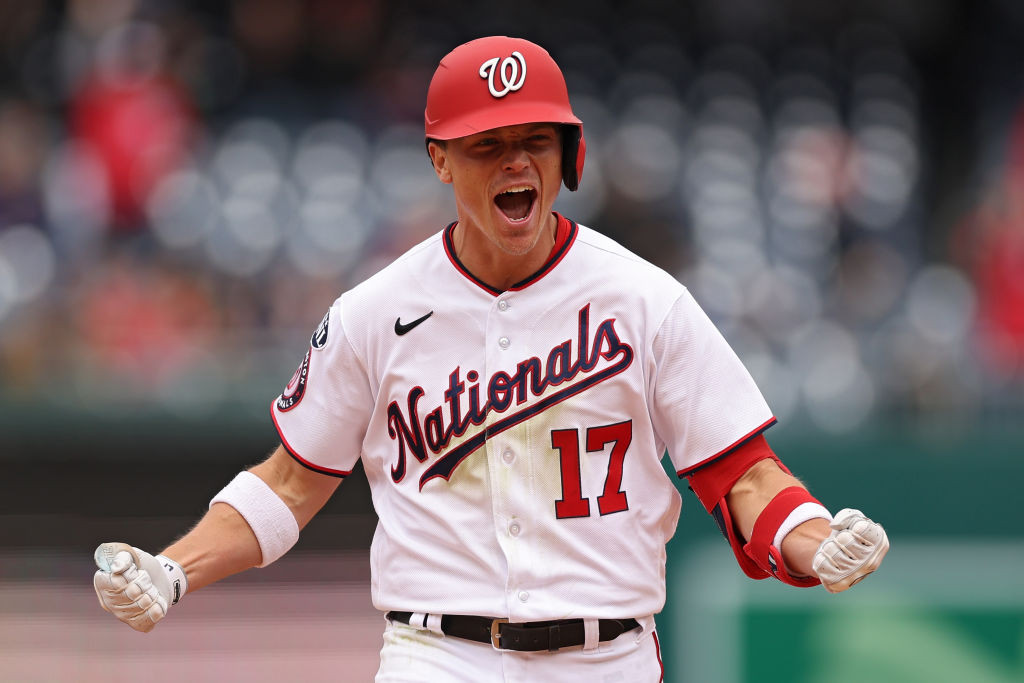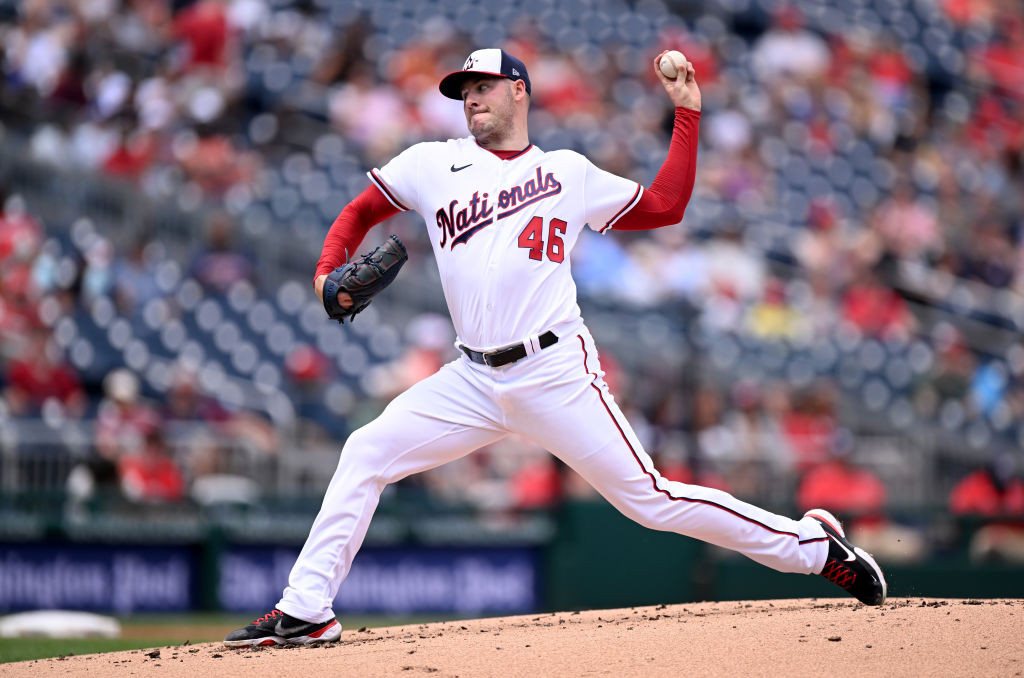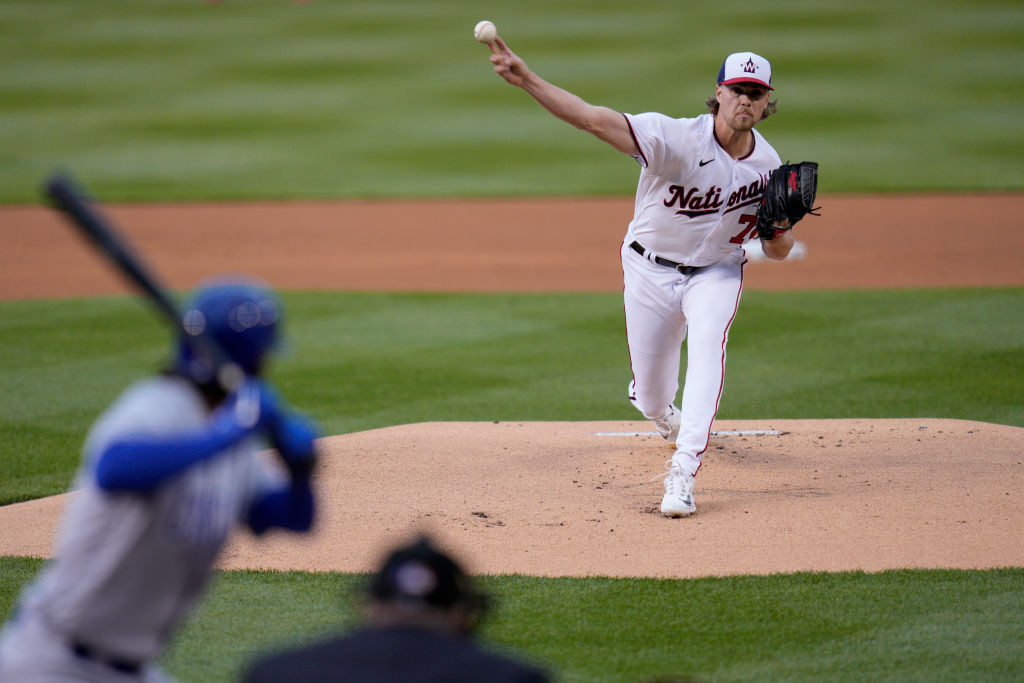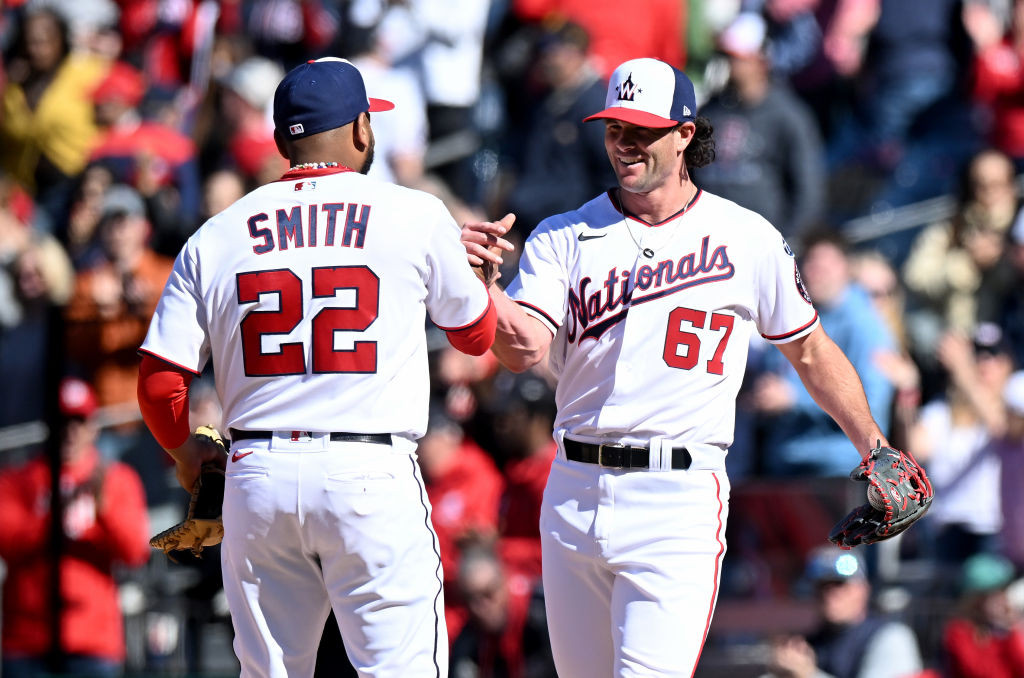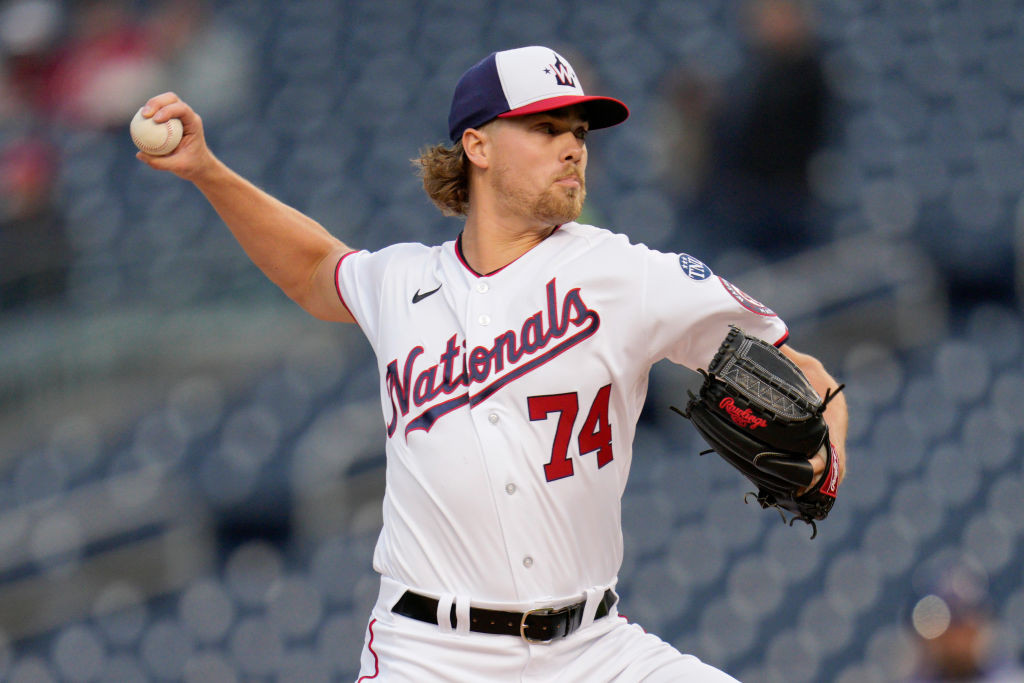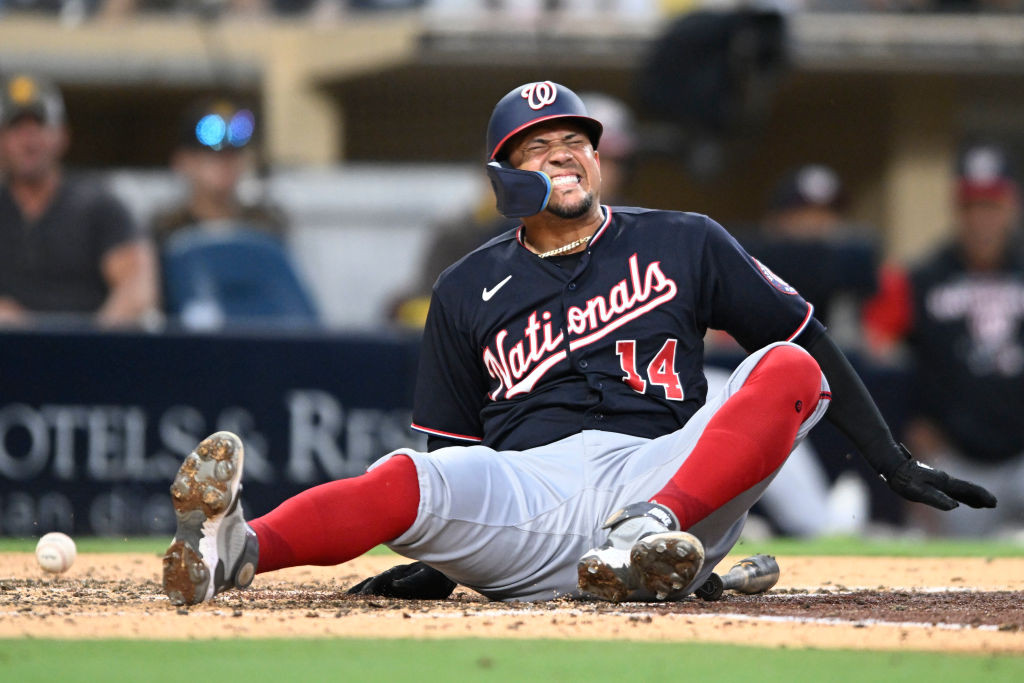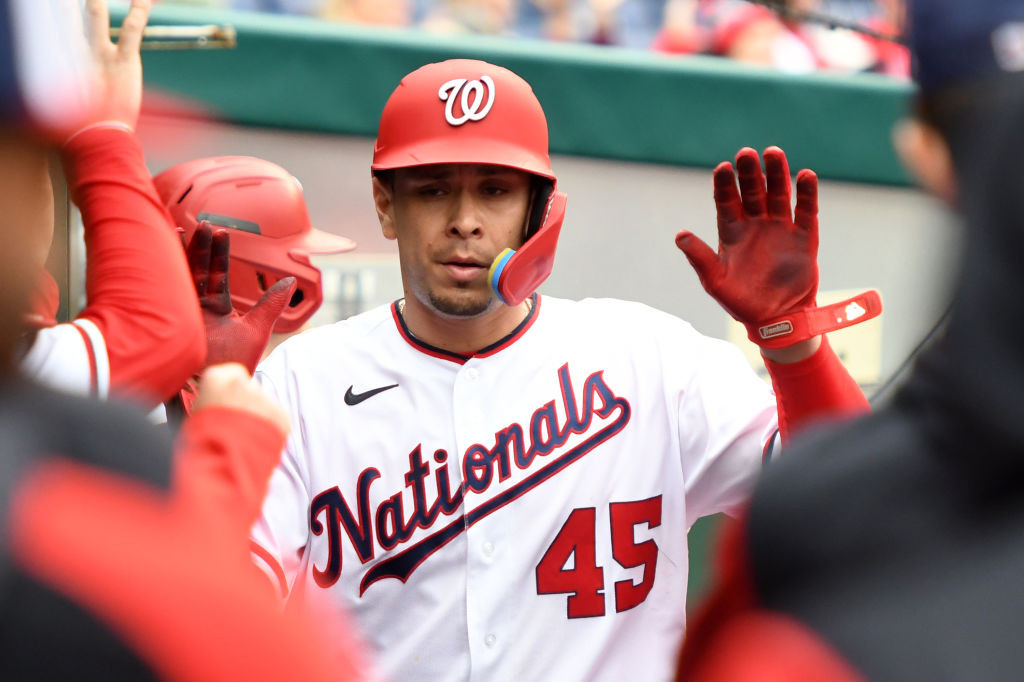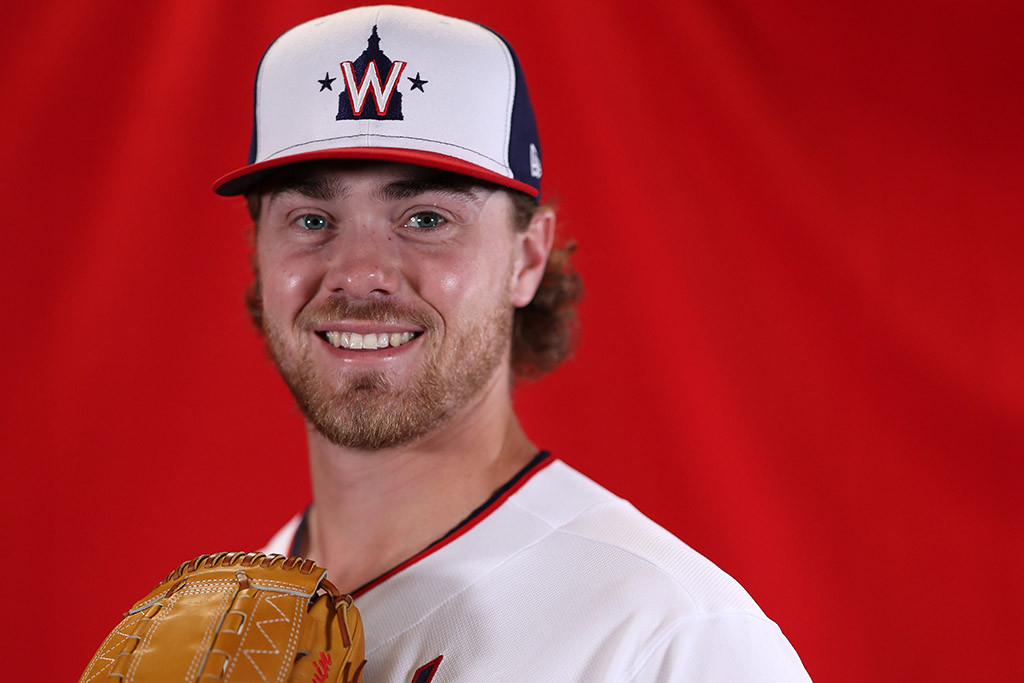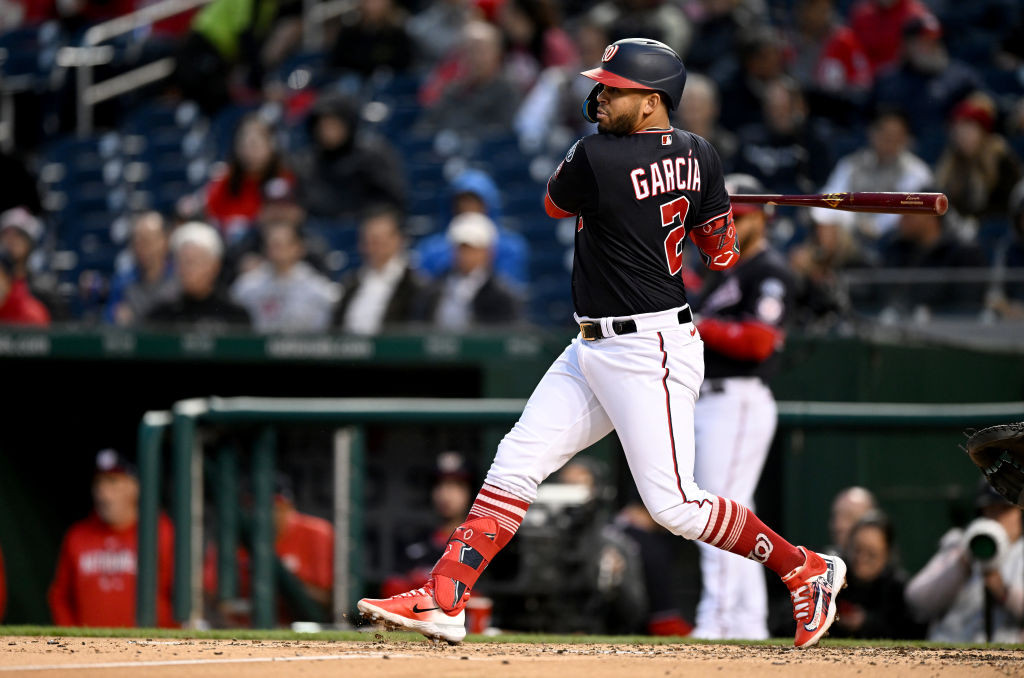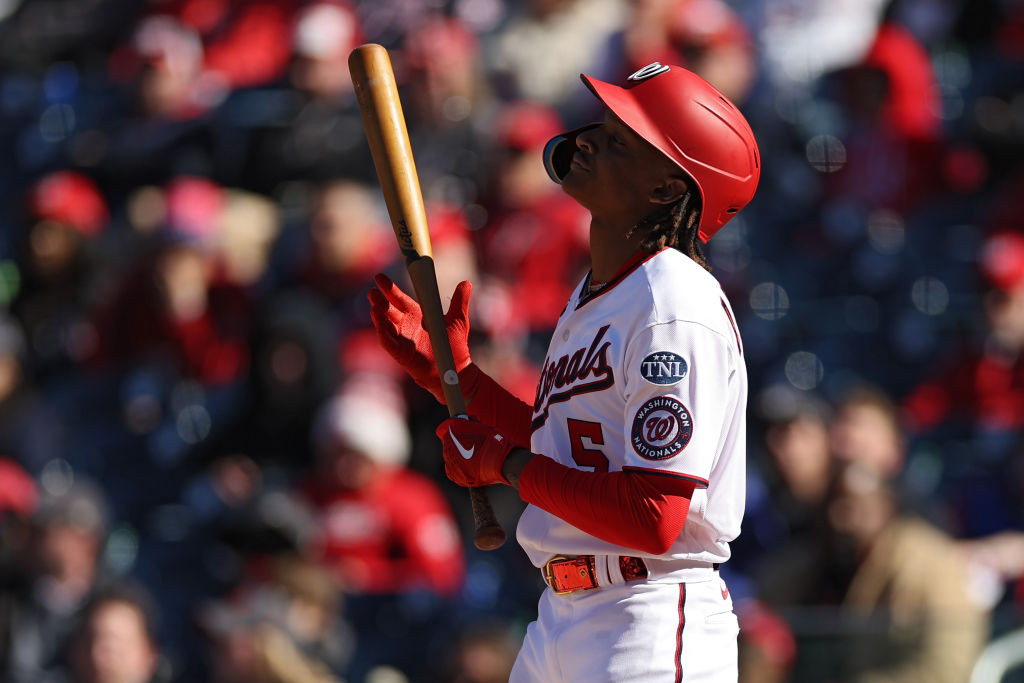PHOENIX – The Nationals once again find themselves needing to win a series finale to avoid a three-game sweep. This is the fifth time already this season it’s happened, but the good news is they’re 3-1 in such matchups, having beaten the Braves, Guardians and Pirates. Only the ridiculously hot Rays managed to pull off a three-game sweep against them.
So they’ll try to make it 4-1 this afternoon when they face the Diamondbacks one last time at Chase Field, this time with the roof closed. The dry air has been good for a power-starved lineup: Luis García, Keibert Ruiz and Lane Thomas have all homered in this series. Unfortunately, Arizona also has hit three homers, including Lourdes Gurriel Jr.’s game-tying blast to lead off the bottom of the ninth Saturday night.
We’ll have to see if Kyle Finnegan is used as closer again today, should the situation present itself. Davey Martinez certainly has an easy out if he wants to sit Finnegan, citing the four games in five days he has pitched. Would he instead go to Hunter Harvey, who has had two days off after pitching back-to-back-to-back days, for his first career save? Stay tuned.
Trevor Williams gets the start, and the right-hander will be looking to pick up right where he left off Tuesday night when he tossed 5 1/3 scoreless innings against the Cubs at Nationals Park. He’s opposed by Diamondbacks right-hander Ryne Nelson, who in six starts this season owns a 6.39 ERA and 1.516 WHIP.
WASHINGTON NATIONALS at ARIZONA DIAMONDBACKS
Where: Chase Field
Gametime: 4:10 p.m. EDT
TV: MASN, MLB.tv
Radio: 106.7 FM, MLB.com
Weather: Roof closed
PHOENIX – A lot happened during Saturday night’s game, a wild 8-7 loss to the Diamondbacks. The Nationals got nine strikeouts from MacKenzie Gore in six innings. They pulled off a five-run rally in the top of the ninth, four of those runs scoring with two outs. They gave it back in the bottom of the ninth when Kyle Finnegan retired only one of the six batters he faced.
There were other developments of note, as well. And those shouldn’t be ignored as you process everything that took place in this highly eventful ballgame …
* Keibert Ruiz snapped out of his slump in a big way.
The young catcher insisted Friday night he wouldn’t hang his head after striking out three times and seeing his slump extend to 0-for-16. He made good on that promise Saturday, delivering a two-run double in the fourth and then a towering homer to lead off the ninth.
These were important swings for Ruiz. Not simply because of the results, but because of the authority with which he connected for those hits. His double carried an exit velocity of 106.4 mph. His homer was actually a bit lower, at 104.7 mph. He even made loud contact on a second-inning groundout to short, a ball that left his bat at 99.7 mph.
PHOENIX – This looked like one of those nights when the Nationals would be left to focus on the positives that emerged from a nondescript loss. Most notably, an ace-like performance from MacKenzie Gore.
Then this looked like one of those nights when the Nationals would celebrate a stunning victory thanks to the five runs they scored in the top of the ninth behind the offensive exploits of Keibert Ruiz, Ildemaro Vargas and Lane Thomas.
But at the end of a wild Saturday night in the desert, all the Nats could do was trudge off the field having suffered their toughest loss of the season, falling to the Diamondbacks, 8-7, after Kyle Finnegan blew an unexpected save opportunity in the bottom of the ninth in agonizing fashion.
"I can't say enough about what our team did, behind like that and coming back," manager Davey Martinez said. "It shows a lot of fight. It shows a lot of the character of our ballclub. And you've got a team over there that's fighting back. Look, we made it a battle. At the end, we couldn't hold the lead."
Entrusted with a one-run lead thanks to his teammates' shocking rally in the top of the inning, Finnegan immediately gave it back on Lourdes Gurriel Jr.'s leadoff homer to left. Despite the pleas of Stone Garrett that a fan reached over the fence to interfere with his play, league officials in New York upheld the home run call, leaving the game tied.
PHOENIX – Jeimer Candelario spent Friday night in a hospital following the Nationals’ game with what doctors ultimately determined was a bout of dehydration.
Candelario appeared to feel fine throughout the game, according to manager Davey Martinez, but shortly after the 3-1 loss to the Diamondbacks felt dizzy and was taken to the trainer’s room at Chase Field to wait for paramedics to arrive. After receiving IV fluids, the 29-year-old third baseman was taken to a nearby hospital for precautionary tests, but was released today once any serious issues were ruled out.
“He went and took a shower, said he didn’t feel well,” Martinez said. “They laid him down. He started shaking pretty good. They came in, we saw a doctor and he deemed he was dehydrated. They gave him some fluids, and he still didn’t feel right. We just wanted to make sure we got him all checked out. Everything checked out.”
It wasn’t particularly warm Friday night, with a gametime temperature of only 79 degrees, but dehydration isn’t uncommon in the desert. Candelario went 1-for-3 with a strikeout and was in the on-deck circle when Joey Meneses struck out to end the game.
Candelario was kept out of tonight’s lineup. It’s the first time he has sat this season; he had been the only player on the team to start each of the Nationals’ 32 games to date.
PHOENIX – Would you believe every run the Nationals have scored the last two days came on a home run? It’s true. Now, they’ve only scored five total runs in that time, and they did so via three homers (Lane Thomas’ three-run blast, Alex Call’s walk-off, Luis Garcia’s solo shot). But this team that typically scores only via singles and doubles hasn’t done so since Wednesday.
They’ll try to change that reversal of fortunes tonight, hoping for more success against the plate against the Diamondbacks’ Tommy Henry than they had against Merrill Kelly in the series opener. Henry, a 25-year-old lefty, is making his 12th big league starts. Through his first 11, he owns a 5.56, 1.482 WHIP and a very low 1.54 strikeout-to-walk ratio. Suffice it to say, this should be a pitcher the Nats can have some success against. (Key word: should.)
It may not take a whole lot of offense to emerge victorious tonight, if MacKenzie Gore can return to form after struggling his last start. The left-hander gave up four runs on seven hits and needed 102 pitches just to record 12 outs against the Cubs, an uncharacteristic performance. Gore intended to work on some things during the week. We’ll see if he’s able to put that into practice tonight against the Arizona lineup.
WASHINGTON NATIONALS at ARIZONA DIAMONDBACKS
Where: Chase Field
Gametime: 8:10 p.m. EDT
TV: MASN, MLB.tv
Radio: 106.7 FM, MLB.com
Weather: Sunny, 85 degrees, wind 9 mph left field to right field
NATIONALS
RF Lane Thomas
2B Luis García
DH Joey Meneses
C Keibert Ruiz
LF Stone Garrett
1B Dominic Smith
CF Victor Robles
3B Michael Chavis
SS Ildemaro Vargas
PHOENIX – Keibert Ruiz has dealt with slumps before. That’s not new. But he hasn’t dealt with one in which the simple act of making contact has become such a challenge.
Nobody on the Nationals roster, and hardly anyone in the majors, is better at putting the bat on the ball than Ruiz, whose 95 percent contact rate on pitches in the strike zone is among the best in the sport.
So when he struck out in his first three at-bats during Friday night’s 3-1 loss to the Diamondbacks, it was notable and unusual. This was only the third time in Ruiz’s career he struck out thrice in one game. And when you add his final at-bat Thursday against the Cubs, he actually endured through a streak of four consecutive plate appearances with a strikeout.
“I just don’t feel like I was feeling like I was a couple days ago,” he said. “I’m not using my legs, not using the same approach. I need to go back to keeping it simple and not try to do too much.”
Ruiz was hardly alone in struggling against Diamondbacks starter Merrill Kelly, who struck out 10 over seven dominant innings. But his struggles were the least characteristic, given his usual ability to make contact.
PHOENIX – Even on an unseasonably cool, 79-degree evening in these parts, the ball always flies well at Chase Field, especially when the roof and outfield panels are open. A power-starved Nationals lineup took the field tonight hoping to take advantage of that in its series opener against the Diamondbacks and throughout the weekend.
Alas, one must actually make contact to have a chance to hit the ball out of any park. And on this night against Merrill Kelly, that seemingly simple task proved far too difficult for the Nats.
Behind a 10-strikeout performance from their right-hander, the Diamondbacks emerged victorious, 3-1, the Nationals once again unable to provide much run support for star-crossed starter Josiah Gray.
Gray wasn’t in peak form tonight, allowing three runs over five innings. But he would’ve needed to be perfect to best Kelly, who had the Nats eating out of his hand.
Even Keibert Ruiz, the best contact hitter on the team and one of the best in the majors, couldn’t get the bat on the ball. The young catcher struck out in all three of his plate appearances against Kelly, his first three-strikeout game this season and only the third of his career.
PHOENIX – Hunter Harvey understands why people will immediately make the connection, believing he blew the Nationals’ 3-0 lead in the eighth inning Thursday because he was pitching for the third straight day for the first time in his career.
The Nationals reliever insists there was no connection between those two facts.
“No, I don’t think it had anything to do with being the third day,” he said. “I just didn’t execute. That could happen when you’re fresh or when you’re not fresh.”
Harvey had already pitched Tuesday, recording five big outs on 21 pitches to help lead the Nationals to victory over the Cubs. He had also pitched Wednesday, tossing a scoreless eighth on 14 pitches to preserve his team’s 2-1 lead and eventual victory.
Through it all, the 28-year-old right-hander felt strong. And when it came time to inform manager Davey Martinez about his availability for Thursday’s game, he didn’t hesitate to offer his services if the situation called for it.
PHOENIX – Hello from the Valley of the Sun, where the temperature is only topping out in the 80s this weekend. Which means the roof at Chase Field will be open both tonight and Saturday. Around here, that’s a huge win.
Speaking of huge wins, the Nationals are coming off a big one over the Cubs to cap a solid homestand. They’ll try to keep their winning ways alive on the road, where they’ve been a much better team so far this season.
The good news: They’ve got Josiah Gray on the mound for tonight’s series opener against the Diamondbacks. The bad news: They almost certainly don’t have either Hunter Harvey or Kyle Finnegan in their bullpen after those guys each pitched the last three days. Quality innings from Gray will be key tonight, and then someone else from Davey Martinez’s bullpen will have to close it out.
A lineup that started to show signs of power back home will hope for more of that in the warm, dry air here. This has always been a good hitter’s park, and it’s even more so when the roof is open. The Nats will try to hit some balls in the air tonight against Arizona right-hander Merrill Kelly.
WASHINGTON NATIONALS at ARIZONA DIAMONDBACKS
Where: Chase Field
Gametime: 9:40 p.m. EDT
TV: MASN2, MLB.tv
Radio: 106.7 FM, MLB.com
Weather: Clear, 79 degrees, wind 12 mph left field to right field
Just over 30 games into the season, who would you guess would be the Nationals’ RBI and slugging percentage leader?
Probably one of their power hitters like Joey Meneses or Dominic Smith. Or maybe even one of their better contact hitters like Jeimer Candelario or Keibert Ruiz.
Any one of them would be a good guess, especially considering how high up the batting order they primarily hit.
But they would be wrong, as the correct answer is CJ Abrams, who is slugging .386 with 15 RBIs over his first 30 games.
“I did know that,” Abrams said with a grin when asked if he knew he was the team’s leader in runs batted in.
The Nationals are enjoying the last three games at home after entering this homestand with a sub-.500 record on South Capitol Street and having dropped two of three to the Pirates over the weekend and the series opener to the Cubs on Monday.
But it all came together these last three days in the forms of a 4-1 win Tuesday, a 2-1 win yesterday and a 4-3 win this afternoon, this one delivered by Alex Call’s walk-off home run down the left-field line to send the announced crowd of 18,577 home happy.
The win was the Nationals’ third in a row and sealed their third series win in their last four matchups. It was also completed in 1 hour and 55 minutes, the third-fastest game in the majors this season.
Coming up for his fourth at-bat, Call had already had an eventful day. Starting in center field for Victor Robles, he made a spectacular diving catch to rob Dansby Swanson of a hit in the seventh and preserve a strong outing by Patrick Corbin. But at the plate, he was less fortunate with an 0-for-3 start and two hard lineouts to third baseman Patrick Wisdom.
That’s why you always look to the next one.
The Nationals will look to win this four-game series against the Cubs this afternoon on South Capitol Street after taking the last two games. A win will also give them a winning homestand. They’ll hop on a flight tonight and embark on a six-game West Coast road trip to Phoenix and San Francisco after finishing with Chicago.
Patrick Corbin will take the mound for his seventh start of the season, fifth at home, bringing his 1-4 record, 5.74 ERA and 1.660 WHIP. The numbers still don’t impress, but Corbin has been better so far this year in keeping the Nationals close. He has departed the game with his team ahead, tied or within two runs in five of his six starts, and he has turned in quality starts in two of his last three outings with a much better 4.15 ERA over those games.
The Cubs will activate Jameson Taillon from the injured list to start for the visitors. The veteran right-hander went down with a groin strain after only three starts, going 0-2 with a 4.50 ERA and 1.357 WHIP. He’s 0-1 with a 3.86 ERA over five career starts against the Nats and 0-1 with a 3.32 ERA over three starts at Nationals Park.
Today will be the Nats’ last chance on this homestand to improve their record at Nationals Park. Overall, they’re 5-12 at home while actually playing above-.500 ball on the road with a 7-6 record. They’re 3-3 so far on this homestand.
CHICAGO CUBS at WASHINGTON NATIONALS
Where: Nationals Park
Gametime: 1:05 p.m. EDT
TV: MASN, MLB.tv
Radio: 106.7 The Fan, MLB.com
Weather: Mostly cloudy, 58 degrees, wind 9 mph in from left to right field
Jake Irvin had a solid major league debut Wednesday for the Nationals.
It wasn’t anything too spectacular, nor was it expected to be. A promising pitcher in his own right, he didn’t come with the pedigree of his former University of Oklahoma teammate Cade Cavalli. And his debut definitely didn’t come with the pomp and circumstance that surrounded the debut of Stephen Strasburg, who remains the last starting pitcher to make his major league debut with the Nationals and earn the win back in June 2010.
But Irvin’s start against the Cubs was still encouraging enough that the Nationals are going to keep him around for a little while longer, though not fully committing to him making another start in the big leagues.
“Yeah, we're gonna keep him around,” manager Davey Martinez said of Irvin during his pregame media session ahead of Thursday’s afternoon finale against Chicago. “We haven't decided yet what we're gonna do for that starter's spot. But if he's here till then, he'll get a chance to start again.”
The 26-year-old right-hander pitched 4 ⅓ innings last night and gave up just one run on two hits and four walks while striking out three, all looking. He threw 81 pitches, 45 strikes, after throwing 82 pitches, 52 strikes, in his previous start for Triple-A Rochester last week. That was his best start with the Red Wings before getting the call to Washington, striking out six and allowing two runs over 5 ⅓ innings.
With two on and nobody out in the top of the ninth Wednesday night, Kyle Finnegan’s thoughts hearkened back 12 days prior, when he faced an identical situation and lived to tell about that.
That cold night in Minnesota, Finnegan pitched his way out of a jam by getting a lineout and then a 5-4-3 double play, preserving a one-run victory for the Nationals. This time, he pulled it off thanks to a fielder’s choice on a bunt, then a 6-4-3 double play, preserving another one-run victory.
“I found myself there a couple times before this year,” Finnegan said. “Knowing that I’ve gotten out of it before helps a lot. And we’ve been turning so many double plays behind us, you know you’re never really out of it.”
Look at Finnegan’s 2023 totals to date, and it’s easy to believe he’s having a disastrous season. His ERA is 6.00. His WHIP is 1.583. He has surrendered three homers in only 12 innings.
That doesn’t accurately reflect his true performance to date, though. Most of those lofty numbers were the direct result of one awful appearance on April 4 against the Rays, when he was roughed up for five runs while recording only one out, surrendering all three of those homers.
Jake Irvin did his part in his major league debut to give the Nationals a chance to win. His teammates then did just enough to actually emerge with the win.
CJ Abrams drove in the go-ahead run in the bottom of the seventh for the second straight night, and the Nats bullpen tossed 4 2/3 innings of scoreless ball following Irvin’s solid-if-abbreviated first career start to beat the Cubs, 2-1, and ensure at least a split of this four-game series.
Called up from Triple-A Rochester to make his debut five years after the organization selected him from the University of Oklahoma in the fourth round of the draft, Irvin survived some occasionally erratic command to hold Chicago’s lineup to one run before departing with one out in the fifth.
The 26-year-old right-hander was rated the Nationals’ 20th-best prospect by MLB Pipeline. He wound up outperforming several far more highly touted pitchers who have come and gone over the years, and gave club officials enough reason to want to see more of him.
"This is something you dream of since the day you pick up a baseball," he said. "I'm on top of the world. And props to the team, man. The guys played great behind me."
The Nationals have their utility man back in the dugout tonight, with Ildemaro Vargas activated from the 10-day injured list about 3 1/2 weeks after he jammed his left shoulder making a diving play in the field.
Vargas rejoins the team after a brief rehab stint with Triple-A Rochester, where he appeared in three games and went 1-for-10 at the plate.
“I watched some of his swings last night,” manager Davey Martinez said. “I know he struck out, but he hit some balls hard. He felt good. He said he had no pain whatsoever.”
The 31-year-old infielder hurt himself April 9 in Colorado when he jammed his shoulder while making a play at second base against the Rockies. He finished the game but was in significant pain the following day, so the Nationals placed him on the IL and called up Jeter Downs to fill his role on the bench.
Downs, 24, wound up appearing in only one game during his three weeks on the big league roster, and that came late in Saturday night’s blowout loss to the Pirates. A onetime top prospect of the Dodgers and Red Sox, he was claimed off waivers this winter by the Nationals, who intended to have him play every day at Triple-A and see if he could recapture the form that made him so coveted he was a key piece in the trade that sent Mookie Betts from Boston to Los Angeles.
There’s nothing quite like a major league debut, especially when the guy debuting is a starting pitcher. No, Jake Irvin isn’t a top prospect in the Nationals organization, and his start tonight isn’t as significant as Cade Cavalli’s debut last summer. But it’s still a big deal for any pitcher who was drafted, developed and moved up the organizational ladder to see his dream come true and start a big league game.
Irvin is no kid; he’s 26 years old, drafted in the fourth round in 2018 out of the University of Oklahoma (where he was teammates with Cavalli, by the way). He missed the 2021 season while recovering from Tommy John surgery but was healthy throughout the 2022 campaign, reaching Double-A Harrisburg. The Nats added him to the 40-man roster this winter, and now they’ve called him up after five starts at Triple-A Rochester.
Irvin isn’t the only addition to the Nationals’ roster for tonight’s game. Infielder Ildemaro Vargas has been activated off the 10-day injured list, his left shoulder now healed. To make room for both players, Jeter Downs and Cory Abbott were optioned back to Rochester.
The Nats will be looking to make it two in a row against the Cubs, who have veteran Marcus Stroman on the mound. The 32-year-old right-hander has been excellent so far, with a 2.29 ERA and a 1.047 WHIP through his first six starts of the season.
WASHINGTON NATIONALS vs. CHICAGO CUBS
Where: Nationals Park
Gametime: 7:05 p.m. EDT
TV: MASN, MLB.tv
Radio: 106.7 FM, MLB.com
Weather: Chance of rain, 53 degrees, wind 14 mph left field to right field
When it came time to decide who to summon from their farm system to start tonight’s game against the Cubs, the Nationals had options. They could’ve gone with someone with considerable big league experience (Wily Peralta), modest big league experience (Paolo Espino) or minimal big league experience (Cory Abbott, Joan Adon).
In the end, they went with zero big league experience.
That’s right, when they take the field this evening, the Nationals will be led by Jake Irvin, a 26-year-old right-hander making his major league debut. It’s a debut most assumed would come sometime this season but few figured would come this soon.
“His last outing, he pitched really well,” said manager Davey Martinez, referencing the two runs Irvin allowed in 5 1/3 innings for Triple-A Rochester one week ago. “He’s stretched out to about 90 pitches. So we’re going to give him an opportunity to come out here and start for us tomorrow, and see what he does and see where he goes.”
A fourth round pick in the 2018 draft out of Oklahoma – where he was rotation mates with 2020 first round pick Cade Cavalli – Irvin is the organization’s 20th ranked prospect according to MLB Pipeline. He missed all of the 2021 season following Tommy John surgery and split last season between Single-A Wilmington and Double-A Harrisburg.
One-plus months into this season, Davey Martinez’s offensive philosophy has become pretty well established, certainly when it comes to his regular 8-9-1 hitters: If CJ Abrams gets on base and there’s an opportunity to play for one run, Victor Robles and/or Alex Call will probably be asked to bunt.
It happened twice tonight, in both the third and fifth innings, and the end result of all that was one run. One that was made possible only because of an error on Robles’ sacrifice bunt attempt in the third.
As such, when Abrams, Robles and Call came back to the plate in the bottom of the seventh, this game was now tied. This time, each was allowed to swing away. And lo and behold, would you guess what happened next? Each delivered a clutch hit, combining to drive in three runs and propel the Nationals to a cathartic, 4-1 victory over the Cubs.
"It's nice to bunt, but you think about giving up outs," Martinez said when asked what made the strategy in the seventh different from the third and fifth. "At that particular moment in the seventh, I said: Hey man, we need to put some runs on the board. And they're swinging the bats well. So you give them a chance to swing. And they came through, which was awesome."
Abrams’ single to right, which brought Dominic Smith home from second, provided the go-ahead RBI. Robles’ infield single, a sharp chopper to third that ate up Patrick Wisdom, kept the rally going. And Call’s double to the gap in left-center brought both of his teammates home and provided the entire dugout reason to celebrate a three-run rally.
On the heels of an impressive 4-2 road trip to Minnesota and New York, the Nationals have sputtered back home. They’re currently 1-3 against the Pirates and Cubs and in danger of assuring another losing homestand if they can’t get things together quickly.
A victory tonight would certainly help. And some offense would certainly help make that more possible.
The Nats were held to one run on six hits Monday night by Drew Smyly and a couple of relievers. They’ll need to be better against Hayden Wesneski, who enters with a 5.24 ERA but has actually pitched quite well in two of his last three starts. The 25-year-old right-hander held the Athletics to one run over seven innings, then held the Padres to one run over five innings last week. He’s averaging only 75.8 pitches per start, so he probably won’t be around too long tonight, if the Nats can make him work a bit.
Trevor Williams gets the ball for the Nationals, facing one of his former teams for the second straight outing. The right-hander had maybe the worst of his starts to date in New York last week, allowing four runs on nine hits over five innings, a performance that kind of got lost in the shuffle because of CJ Abrams’ late grand slam and Mason Thompson's struggles after that during a 9-8 loss to the Mets.
WASHINGTON NATIONALS vs. CHICAGO CUBS
Where: Nationals Park
Gametime: 7:05 p.m. EDT
TV: MASN, MLB.tv
Radio: 106.7 FM, MLB.com
Weather: Chance of rain, 56 degrees, wind 11 mph left field to right field


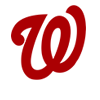

-1745819772711.png)
